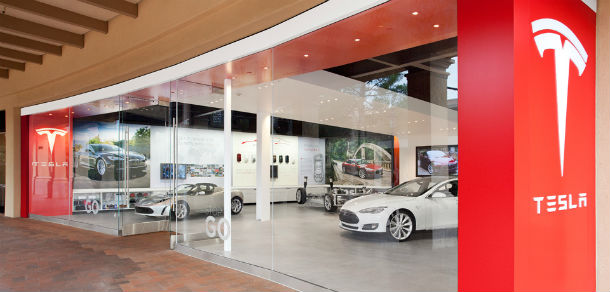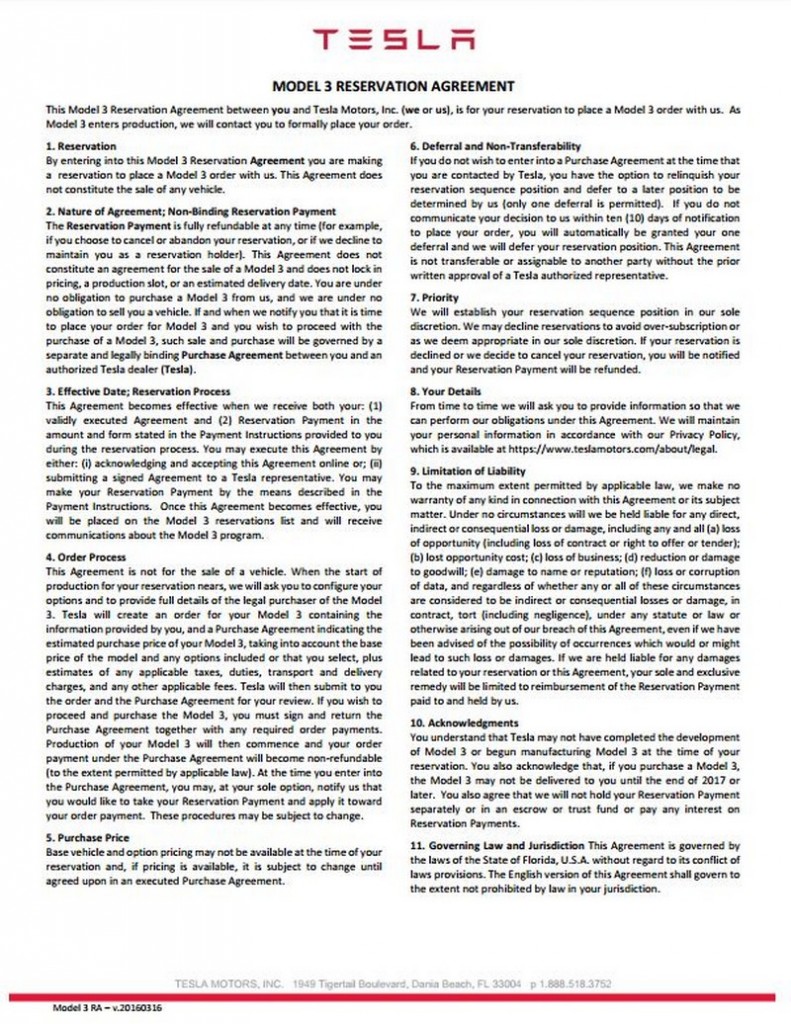

News
Details Behind the Tesla Model 3 Reservation Agreement
The Tesla Model 3 Reservation Agreement is available at the company website. It makes it clear that people who reserve a Model 3 are not buying a car. They are reserving a ride on the road to the future.
Prospective Model 3 reservation holders will need to agree to the Tesla Model 3 Reservation Agreement come Thursday, regardless of whether they plan on placing a deposit in stores or online later in the evening. That agreement will then be submitted to the company along with your deposit. The one page document is written in standard English rather than impenetrable legalese, so congratulations to Tesla for doing that. Here are a couple of significant points contained in the agreement you should be aware of.
The Agreement is not a sales contract
The Model 3 Reservation Agreement makes it clear that it is not a sales contract. It is nothing more than an opportunity to enter into a sales contract at some point in the future. It says the reservation fee, which is $1,000 in the United States, is fully refundable if the prospective purchaser decides to cancel or abandon the reservation. It also says Tesla may “decline to maintain you as a reservation holder.” You may want to refrain from saying negative things about Tesla publicly to keep that from happening. If and when Tesla decides it is time for you to enter into a validly binding sales contract, it will notify you.
Deferral and non-transferability
If and when the time comes to place an order for a Model 3, and the reservation holder decides not to proceed with signing a sales contract, they will be permitted to defer reservation until a later time. Only one deferral is permitted. Those looking to make a quick profit by selling their early reservation should take note that it is not transferable.
Priority
There has been much discussion in the past few weeks about getting a low reservation number. People are fanatically interested in getting their Model 3 before the federal tax credit for Tesla vehicles begins to expire. Others just want to be the first on their block to own one. Either way, just being first in line at your local Tesla store on March 31 won’t necessarily determine your place in the Model 3 reservation queue. The Reservation Agreement makes that crystal clear.
“We will establish your reservation sequence position in our sole discretion. We may decline reservations to avoid over-subscription or as we deem appropriate in our sole discretion. If your reservation is declined or we decide to cancel your reservation, you will be notified and your Reservation Payment will be refunded.”
Limitation of liability
Tesla anticipates that a few customers may become annoyed with the Model 3 ordering process at some point in the future. There may be delays. Specifications for the car may change. Any number of things could happen that could be contrary to a buyer’s expectations at the time the reservation was made. Can you sue Tesla for disappointing you? No, you cannot. Forget about it.
Acknowledgements when you sign a Reservation Agreement
When you sign your Reservation Agreement and hand it to a Tesla representative or transmit it electronically, Tesla wants you to know a few more things.
“You understand that Tesla may not have completed the development of Model 3 or begun manufacturing Model 3 at the time of your reservation. You also acknowledge that, if you purchase a Model 3, the Model 3 may not be delivered to you until the end of 2017 or later. You also agree that we will not hold your Reservation Payment separately or in an escrow or trust fund or pay any interest on Reservation Payments.”
In other words, when you sign on the dotted line on March 31 or any later date, you should be aware that the Model 3 is still a work in process. What you see at the official reveal may or may not be the car that will be built for you in the future. It could have more or less doors. It could look substantially different. What you see may not be what you get.
Summary
Make no mistake about it, Tesla intends to build the Model 3 and lots of them. It just wants you to understand that by reserving one now, you are only getting the right to purchase something in the future. What that something is remains totally up to Tesla to decide. Since all reservations fees are fully refundable, you have nothing to lose. You are reserving a ride on the road to the future. Enjoy your journey but be prepared for some twists and turns along the way.
More Tesla Model 3 News

Elon Musk
Starlink passes 9 million active customers just weeks after hitting 8 million
The milestone highlights the accelerating growth of Starlink, which has now been adding over 20,000 new users per day.

SpaceX’s Starlink satellite internet service has continued its rapid global expansion, surpassing 9 million active customers just weeks after crossing the 8 million mark.
The milestone highlights the accelerating growth of Starlink, which has now been adding over 20,000 new users per day.
9 million customers
In a post on X, SpaceX stated that Starlink now serves over 9 million active users across 155 countries, territories, and markets. The company reached 8 million customers in early November, meaning it added roughly 1 million subscribers in under seven weeks, or about 21,275 new users on average per day.
“Starlink is connecting more than 9M active customers with high-speed internet across 155 countries, territories, and many other markets,” Starlink wrote in a post on its official X account. SpaceX President Gwynne Shotwell also celebrated the milestone on X. “A huge thank you to all of our customers and congrats to the Starlink team for such an incredible product,” she wrote.
That growth rate reflects both rising demand for broadband in underserved regions and Starlink’s expanding satellite constellation, which now includes more than 9,000 low-Earth-orbit satellites designed to deliver high-speed, low-latency internet worldwide.
Starlink’s momentum
Starlink’s momentum has been building up. SpaceX reported 4.6 million Starlink customers in December 2024, followed by 7 million by August 2025, and 8 million customers in November. Independent data also suggests Starlink usage is rising sharply, with Cloudflare reporting that global web traffic from Starlink users more than doubled in 2025, as noted in an Insider report.
Starlink’s momentum is increasingly tied to SpaceX’s broader financial outlook. Elon Musk has said the satellite network is “by far” the company’s largest revenue driver, and reports suggest SpaceX may be positioning itself for an initial public offering as soon as next year, with valuations estimated as high as $1.5 trillion. Musk has also suggested in the past that Starlink could have its own IPO in the future.
News
NVIDIA Director of Robotics: Tesla FSD v14 is the first AI to pass the “Physical Turing Test”
After testing FSD v14, Fan stated that his experience with FSD felt magical at first, but it soon started to feel like a routine.

NVIDIA Director of Robotics Jim Fan has praised Tesla’s Full Self-Driving (Supervised) v14 as the first AI to pass what he described as a “Physical Turing Test.”
After testing FSD v14, Fan stated that his experience with FSD felt magical at first, but it soon started to feel like a routine. And just like smartphones today, removing it now would “actively hurt.”
Jim Fan’s hands-on FSD v14 impressions
Fan, a leading researcher in embodied AI who is currently solving Physical AI at NVIDIA and spearheading the company’s Project GR00T initiative, noted that he actually was late to the Tesla game. He was, however, one of the first to try out FSD v14.
“I was very late to own a Tesla but among the earliest to try out FSD v14. It’s perhaps the first time I experience an AI that passes the Physical Turing Test: after a long day at work, you press a button, lay back, and couldn’t tell if a neural net or a human drove you home,” Fan wrote in a post on X.
Fan added: “Despite knowing exactly how robot learning works, I still find it magical watching the steering wheel turn by itself. First it feels surreal, next it becomes routine. Then, like the smartphone, taking it away actively hurts. This is how humanity gets rewired and glued to god-like technologies.”
The Physical Turing Test
The original Turing Test was conceived by Alan Turing in 1950, and it was aimed at determining if a machine could exhibit behavior that is equivalent to or indistinguishable from a human. By focusing on text-based conversations, the original Turing Test set a high bar for natural language processing and machine learning.
This test has been passed by today’s large language models. However, the capability to converse in a humanlike manner is a completely different challenge from performing real-world problem-solving or physical interactions. Thus, Fan introduced the Physical Turing Test, which challenges AI systems to demonstrate intelligence through physical actions.
Based on Fan’s comments, Tesla has demonstrated these intelligent physical actions with FSD v14. Elon Musk agreed with the NVIDIA executive, stating in a post on X that with FSD v14, “you can sense the sentience maturing.” Musk also praised Tesla AI, calling it the best “real-world AI” today.
News
Tesla AI team burns the Christmas midnight oil by releasing FSD v14.2.2.1
The update was released just a day after FSD v14.2.2 started rolling out to customers.

Tesla is burning the midnight oil this Christmas, with the Tesla AI team quietly rolling out Full Self-Driving (Supervised) v14.2.2.1 just a day after FSD v14.2.2 started rolling out to customers.
Tesla owner shares insights on FSD v14.2.2.1
Longtime Tesla owner and FSD tester @BLKMDL3 shared some insights following several drives with FSD v14.2.2.1 in rainy Los Angeles conditions with standing water and faded lane lines. He reported zero steering hesitation or stutter, confident lane changes, and maneuvers executed with precision that evoked the performance of Tesla’s driverless Robotaxis in Austin.
Parking performance impressed, with most spots nailed perfectly, including tight, sharp turns, in single attempts without shaky steering. One minor offset happened only due to another vehicle that was parked over the line, which FSD accommodated by a few extra inches. In rain that typically erases road markings, FSD visualized lanes and turn lines better than humans, positioning itself flawlessly when entering new streets as well.
“Took it up a dark, wet, and twisty canyon road up and down the hill tonight and it went very well as to be expected. Stayed centered in the lane, kept speed well and gives a confidence inspiring steering feel where it handles these curvy roads better than the majority of human drivers,” the Tesla owner wrote in a post on X.
Tesla’s FSD v14.2.2 update
Just a day before FSD v14.2.2.1’s release, Tesla rolled out FSD v14.2.2, which was focused on smoother real-world performance, better obstacle awareness, and precise end-of-trip routing. According to the update’s release notes, FSD v14.2.2 upgrades the vision encoder neural network with higher resolution features, enhancing detection of emergency vehicles, road obstacles, and human gestures.
New Arrival Options also allowed users to select preferred drop-off styles, such as Parking Lot, Street, Driveway, Parking Garage, or Curbside, with the navigation pin automatically adjusting to the ideal spot. Other refinements include pulling over for emergency vehicles, real-time vision-based detours for blocked roads, improved gate and debris handling, and Speed Profiles for customized driving styles.









